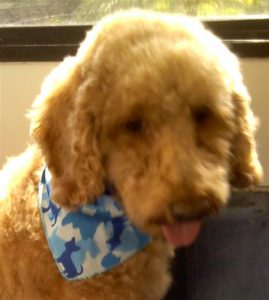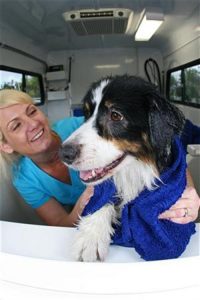Should I Express My Dog’s Anal Glands?
 We’ve all seen dogs communicate – with a lot of sniffing “you-know-where.” While it might be annoying to watch our dog sniff the behind of every other canine he or she comes across, that’s how they identify others in their species. I guess as humans we are lucky that we rely on sight, not smell for identification!
We’ve all seen dogs communicate – with a lot of sniffing “you-know-where.” While it might be annoying to watch our dog sniff the behind of every other canine he or she comes across, that’s how they identify others in their species. I guess as humans we are lucky that we rely on sight, not smell for identification!
What’s The Deal With Anal Glands?
The reason dogs sniff other dog’s behind is to catch a whiff of their anal scent glands. These glands are situated at the end of the anal canal and are stimulated to released scent liquid with each bowel movement. Sometimes the glands become blocked or irritated, or sometimes due to soft stools don’t work efficiently. If a dog isn’t expressing the liquid from these glands with each bowel movement as nature intended, you might need to express them manually or have your vet or groomer do it. Keep in mind that anal gland expression should only be done if there are signs of a blockage or problem.
What Are the Signs My Dog’s Glands Need Expressed?
Some signs that you might need to express the anal glands are: scooting, licking, and general obsession with the anal area. If your dog has had problems with their anal glands in the past, your vet may recommend that you have them expressed regularly — and that makes sense. However, don’t keep having your dog’s anal glands expressed just because “the groomer always does it.” Even if your dog is of a breed that commonly needs to have their glands expressed, your particular pup may be getting the job done naturally all by himself. In this case there is absolutely no reason for us humans to interfere with an intrusive and ultimately unnecessary procedure.
How to Express the Glands
 If expressing anal glands sounds gross, that’s because it can be. This isn’t a job for the squeamish. You’ll need gloves, tissues, and a lot of bravery. Whatever you do – don’t do this over carpet. The liquid released can have a strong, foul odor. Once it gets into your carpet, the smell will last. The glands are found at the very end of the anal cavity, one on either side of the anus, located generally around 4 o’clock and 8 o’clock. There are two recognized methods of expressing the glands. With the external method of expressing anal glands, you press on the outside with a tissue over the anus (kind of like popping a zit). With the internal method of expressing the anal glands, you place a finger inside the anal cavity and with your thumb outside, “milk” each gland into a tissue. Either way, it’s fairly disgusting, and the dog isn’t all that happy with it either.
If expressing anal glands sounds gross, that’s because it can be. This isn’t a job for the squeamish. You’ll need gloves, tissues, and a lot of bravery. Whatever you do – don’t do this over carpet. The liquid released can have a strong, foul odor. Once it gets into your carpet, the smell will last. The glands are found at the very end of the anal cavity, one on either side of the anus, located generally around 4 o’clock and 8 o’clock. There are two recognized methods of expressing the glands. With the external method of expressing anal glands, you press on the outside with a tissue over the anus (kind of like popping a zit). With the internal method of expressing the anal glands, you place a finger inside the anal cavity and with your thumb outside, “milk” each gland into a tissue. Either way, it’s fairly disgusting, and the dog isn’t all that happy with it either.
The smelly liquid will be brown, slightly oily, perhaps pasty if they have been blocked. If you think your dog has a problem with their anal glands and that you are squeezing in the proper place but aren’t getting any fluid, then have your dog checked out by a vet if they continue to scoot. Don’t just keep squeezing harder as it is possible to rupture the glands, and that is a serious medical situation.
If you’re at all unclear on how to express anal glands, but want to do it yourself, consult with your vet. Have them watch and talk you through the procedure as you give it a try for the first time.
How to Avoid the Whole Mess
Inducing a firmer stool can keep you from needing to manually express the glands. So you may be able to avoid having these lovely expressing sessions simply by feeding your dog high quality dog food with plenty of fiber. Raw chicken has been used by some pet owners, with the bones in. (But never feed dogs cooked chicken bones as the bones can splinter in a sharp pattern that can puncture the digestive organs.)
Dogs that are overweight, are small breeds, and have soft stools are much more likely to need their glands expressed. Happily, many dogs will go their whole lives with never needing their glands expressed. Larger breeds are less likely to need their glands expressed, but keep an eye open for chronic scooting no matter your dog’s size…and consult your vet if you have any questions
If your dog isn’t exhibiting signs that their anal glands are blocked, having anal glands expressed should be put off. Many dogs go through their entire lives never needing expression. It shouldn’t be a staple of grooming unless it is absolutely needed.
